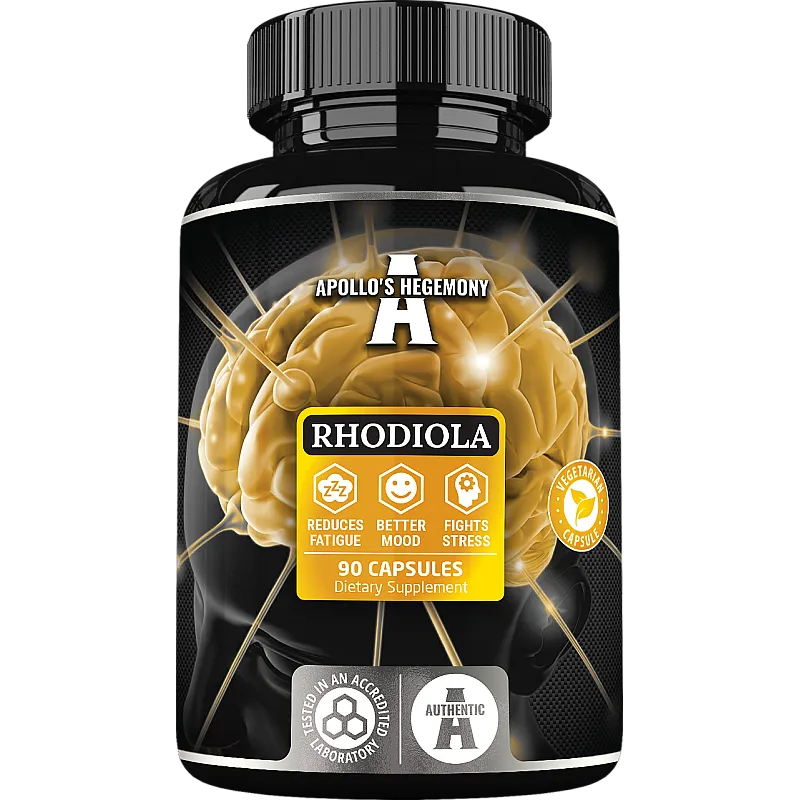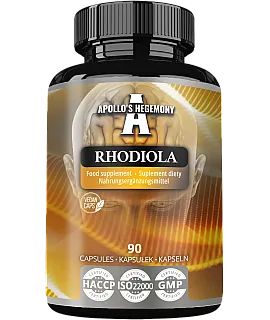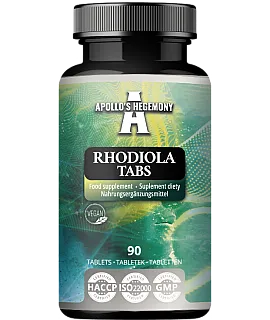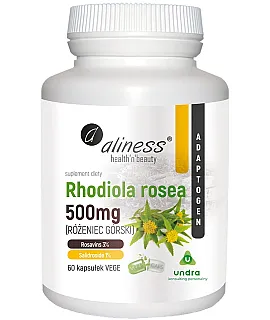Salidrosides from Rhodiola rosea root - how do they work and what do you need to know about them?

In plant extracts, standardization is very important. It ensures that we are providing just the right amount of the active ingredient we need with the supplement. Without standardization, we would be relying only on the belief that there are the right ingredients in the extract in the right amounts, because no one guarantees it. In the case of Rosacea extracts, we usually see standardization for rosavins and salidrosides. More and more data indicate that salidrosides are the more important ones, as they show more significant activity in the body. In this article, we'll examine theory and practice, i.e. how salidrosides work, what health benefits they can bring, and how best to supplement them. Read to the end!
.
Salidrosides - what are they?
Salidrosides (a.k. a. rhodiolosides) are one of the active constituents of plants of the genus Rhodiola. You probably associate them mainly with supplements containing Rhodiola rosea (Rhodiola rosea) extract. Indeed, it is one of the main sources of this substance in nature. Although for a long time the hallmark of R. rosea was mainly the presence of rosavins, salidrosides are now increasingly recognized as the main bioactive components in its roots.
Chemically, salidrosides are phenylethanol derivatives, as is tyrosol (a salidroside derivative), which is also contained in Rhodiola root. Studies show that they are very versatile substances that exhibit many health-promoting properties.
Mechanisms of action of salidrosides
Scandinavian scientists, led by Alexander Panossian, have made a very large contribution to the knowledge of the action of salidrosides. In recent years, however, more and more publications on salidrosides have come out of the hands of Chinese scientists. Since Rhodiola is one of the most popular adaptogens in supplementation, its ingredients have been extremely well studied. Not only do we have many publications describing the effects of Rhodiola extract as a whole, but also detailed information about the actions and properties of its individual components. Below you will find a summary of information on the most important properties of salidrosides.
MAO-B inhibition
MAO stands for the enzyme monoamine oxidase. Its function is to metabolize monoamines, which include neurotransmitters such as serotonin, dopamine and norepinephrine.
It has been carefully analyzed how various active ingredients from Rosacea affect monoamine oxidase activity. Salidrosides showed the ability to inhibit MAO-B, the fraction of the enzyme that acts in peripheral tissues. The activity was ~36% of that of the reference drug[1], selegiline (a drug used in Parkinson's disease).
MAO inhibition is one of the most important properties of salidrosides, but interestingly, there are many more components in Rosacea root that affect this enzyme. Most impressive is Rosicidin, which inhibits MAO-A with 16% of the potency of the reference drug, and MAO-B with as much as 84% of the potency of selegiline.
At this point, one of the main features by which salidrosides are superior to rosavins is revealed. Studies show that rosavins have virtually no effect on MAO activity[1].
Effects on gene expression
How Rosacea extract affects gene expression has been studied. Changes were noticed in 1,062 different genes. With this specifically, salidrosides affected 1052 of them[2]. Thus, it is one of the main substances affecting gene transcription.
Changes in these specific genes affected by salidrosides and Rhodiola mainly affect these areas of bodily function:
- communication between innate and acquired immune cells,
- eNOS signaling,
- T and B cell signaling in rheumatoid arthritis,
- axon conduction signaling,
- G protein-coupled receptor signaling,
- glutamate receptor signaling,
- ephrin receptor signaling,
- cAMP-mediated signaling,
- atherosclerosis signaling pathways.
Genes affecting points 4 through 8 are associated with effects on behavior and mental health. Interfering with these genes with the help of Rosacea makes it possible to reduce emotional and aggressive behavior, confirming the results of preclinical and clinical studies on the use of this plant for depression and anxiety[2].
What are the effects of using salidrosides?
Completely isolated salidrosides are not available in dietary supplements, and we can only supply them from rhodiola extracts. Even when we use an extract in which only standardization to salidrosides is indicated, this does not mean that there are no other active substances in it. Practical effects, therefore, are always the product of the properties of the entire concoction of active substances, not just the one declared on the label. The difference is that the exact content of salidrosides is known, while the presence and even more so the amount of the other substances remains a mystery.
Rhodiola rosea roots have been used for centuries in traditional medicine in Asia, Scandinavia and Eastern Europe[1] for:
- stimulating the nervous system,
- improving physical and mental performance,
- improving resistance to altitude sickness,
- relieving fatigue, mental stress and depression.
Currently, the main purposes of using standardized extracts of Rhodiola rosea are to increase resistance to stress (adaptogenic effect) and improve well-being. Below is a description of Rhodiola's most important properties attributable to salidrosides.

Effects on mood
This is the nail of the show. Supplements with Rhodiola, and therefore salidrosides, are mainly used to simply feel better and healthier. Research results suggest that such supplementation may even give a substitute for an antidepressant effect. This is largely influenced by MAO inhibition and changes in the expression of genes that control neurobiochemistry. The resulting improvement in neurotransmission and stimulation of neurohormones provides better conditions in the brain for maintaining an optimal mental emotional state and simply feeling better. A reduction in feelings of fatigue is also often noted.
Neuroprotective properties
The neuroprotective properties of salidrosides have been highlighted more intensively in recent years. At this point, many reports are still from preclinical studies, but the overall conclusions are very interesting and promising. Both salidroside and the related tyrosol readily cross the blood-brain barrier and act directly in the brain to protect neurons from degeneration.
For example, in experimental models of ischemic stroke, salidroside helped protect the nervous system by significantly reducing infarct size, preventing brain swelling and improving neurological function[3].
The primary mechanisms to which salidrosides owe their neuroprotective potential include antioxidant, anti-inflammatory and anti-apoptotic effects through regulation of multiple signaling pathways and key molecules, such as the NF-κB pathway, TNF-α and PI3K/Akt[3].
Adaptogenic properties
Rhodiola rosea is famous for being an adaptogen, a substance that increases the body's resistance to stress in a non-specific way. Salidroside is one of the main reasons for this fame, as it is largely responsible for the adaptogenic properties[4].
The adaptogenic effect of salidroside has been reported in many scientific publications, and this property is due to the actions described in the previous paragraphs, namely the effect on genes and neurotransmission.
Salidroside supplementation in practice
We can take salidrosides in the form of standardized extracts of the Rhodiola rosea or Rhodiola crenulata plants. In practice, the R. crenulata species is not yet such a popular raw material in supplements, so you will most likely choose a supplement with R. rosea.
The most common standardizations for salidrosides are 1%, 3% or 5%. At a concentration of 1% salidrosides, a standardization for 3% rosavins is usually also indicated, while at higher concentrations the exact amount of rosavins is less often declared.
Currently in Poland, the maximum allowable amount of salidrosides in a daily serving of a supplement is 5 milligrams. In practice, most supplements containing Rhodiola alone provide just 5 mg of salidrosides in 1 capsule or tablet.
Consumer experience, however, does not always follow official recommendations. Since knowledge of the greater importance of salidrosides over rosavins began to be more strongly disseminated, users are more likely to opt for supplementation with increased amounts of salidrosides (up to 15 mg per day), as indicated by numerous reports in online forums and similar sources.
What to watch out for?
Definitely for interactions. The most serious problem with salidrosides, but also with other components of Rhodiola, is that through lack of awareness of the problem, some patients may combine them with drugs against which there is a negative interaction. Especially problematic are antidepressants, sleeping pills, painkillers and neurological drugs.
Salidrosides are MAO inhibitors, and this should always turn on a red light when any drugs from the aforementioned groups are used simultaneously. It's always a good idea to make sure there is no interaction with a particular drug that could clearly exacerbate its effects and increase the risk of side effects.
Besides, both Rhodiola as a whole and salidrosides themselves are considered safe and non-toxic in normally taken doses.
Summary
Salidrosides are among the most important components of the Rhodiola rosea root. They affect the expression of more than 1,000 genes, which has extensive effects on brain function and beyond. Salidrosides have a multifunctional effect: they inhibit monoamine oxidase, improve neurotransmission, have adaptogenic, antioxidant and anti-inflammatory effects. When choosing a supplement with Rhodiola rosea extract, it's definitely worth checking that the standardization for salidrosides is stated.
Sources:
 ⮜ Previous article
⮜ Previous article
Collagen - properties and action. How does it affect our health?
 Next article ⮞
Next article ⮞



